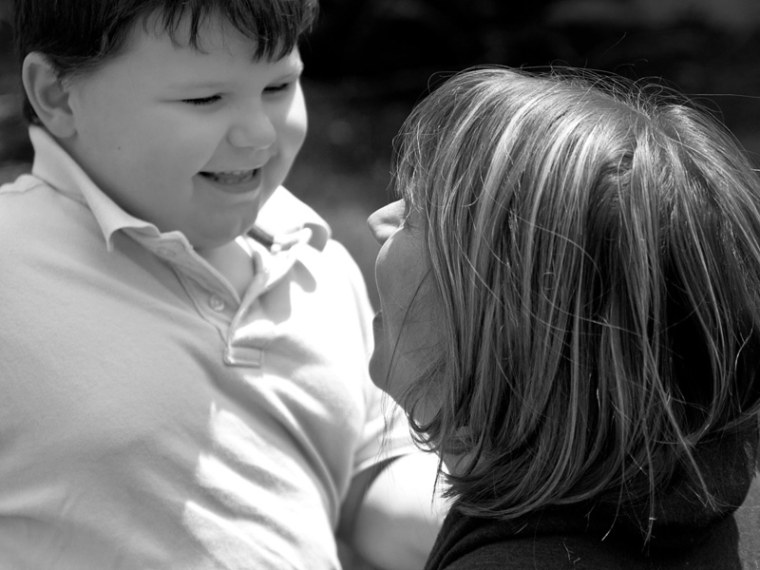Karen Melville remembers when her son Danny was diagnosed with autism so severe that his doctor feared he might never even talk, much less go to school. “It was like a freight train hit,” said Melville, a 39-year-old mother of two who lives in Brunswick, Ohio.
Five years of intensive therapy have paid off. Danny, now age 7, is OK’d to go to school next year in a mostly mainstream class that will have a total of three “high functioning” kids with autism. “Now when he finds something he thinks is really cool on the computer -- like a humpback whale swimming -- he wants to show me,” Melville said.
Danny may be one of what researchers are now calling “bloomers” – kids who start out as severely affected but who manage to grow beyond most of their symptoms.
About 10 percent of children who are severely affected by autism at age 3 seem to have “bloomed” by age 8, leaving behind many of the condition’s crippling deficits, a new study shows. And while these “bloomers” still retain some of autism’s symptoms, like the tendency to rock back and forth when stressed or to repeat the same behavior over and over, they become what experts dub, “high functioning,” according to the study published today in Pediatrics. That means their social skills and their ability to communicate have vastly improved.
Related story: Divorce after autism diagnosis
A child at the low end of the communication scale might not be able to talk, or even to make any sounds, explained the study’s lead author Christine Fountain, a postdoctoral fellow at Columbia University. Those at the other end of the scale “would have a broad vocabulary, understand the meaning of words and use them in appropriate contexts, understand the meaning of story plot and carry on complex conversations,” she explained.
Similarly, a child with a low score on the social scale would have problems interacting with others and would not be able to make friends or socialize. At the high end of the scale, is a child who “would initiate one-on-one interactions with both peers and others in familiar and unfamiliar settings, initiate and maintain friendships, and not need encouragement to participate in social activities,” Fountain said.
”Bloomers” are edging up towards the upper half of both those scales.
Fountain and her colleagues didn’t expect to see kids jump from the low end to the high end in just a few short years. “It was a surprise to see how much improvement they showed – and how quickly,” Fountain said. “That’s kind of hopeful message.”
Hopeful because the odds of such big improvements might rise if more kids got the right kind of therapy early in life, Fountain said.
The researchers studied the records of 6,975 California children who had been diagnosed with autism. They found that many of the children showed improvements between ages 3 and 8, but some, the bloomers, showed startling progress, moving from the most severely affected to some of the highest functioning.
Kids who are older can continue to make progress, but more slowly, experts say. While many of their symptoms fade, they still retain the autism diagnosis.
Fountain and her colleagues suspect, after scrutinizing the differences between children who bloomed and those who didn’t, that it likely comes down to which kids were able to get early, intensive therapy since the children who improved the most had parents with more education and financial wherewithal. Researchers say that it’s possible there might be something inherently different about the children themselves who are “bloomers,” but they don’t know that for sure.
As they delved into the bloomers backgrounds, the researchers found that these children were more likely than others to have mothers with at least a high school education and to come from a higher socio-economic class. (They didn’t have information on the fathers.) Bloomers also tended not to have any intellectual disabilities.
The findings don’t surprise autism expert Tamar Apelian.
“Most children need about 30 to 40 hours a week of intervention,” said Apelian, a staff psychologist at the autism evaluation clinic at the University of California, Los Angeles. “What’s tricky is being able to navigate the system to get the therapy, especially with the state budget crisis. The parents who do this seem to have more means and they can hire an advocate or a lawyer.”
And that’s where parents’ backgrounds come in to play.
After absorbing Danny’s diagnosis at 25 months, Karen asked his doctor about the future. “I said, ‘OK, what can we do about it?’ The doctor said, ‘How much money do you have?’”
The Melville’s weren’t independently wealthy. They were comfortably middle class – but that certainly doesn’t pay for therapy that can cost upwards of $70,000 per year. So that meant the Melvilles had to be creative to get Danny what he needed.
While Danny waited for his turn to come up on program waiting lists the Melvilles found a student to work with him. In the meantime, Danny’s dad, Michael, went back to school to get certified as a pharmacy tech so he could get a job at a university that came with benefits including a break on Danny’s therapy.
The family scraped together money from a variety of sources and finally managed to get Danny into an intensive program that offered one-on-one help.
“When I think back, I think about how I sat and watched for hours waiting for him to make that first sound,” Karen said. “I think about how grim things looked. I can’t stress enough that people determine what it is their children need and then get on those waiting lists. Keep digging and fighting to find someone to start with. It doesn’t matter if it’s a student while you’re on the waiting list. It’s just so important to get help early."
Do you know an autistic child? Has anything helped lessen the symptoms? Tell us on Facebook.
Families of kids with autism earn less
